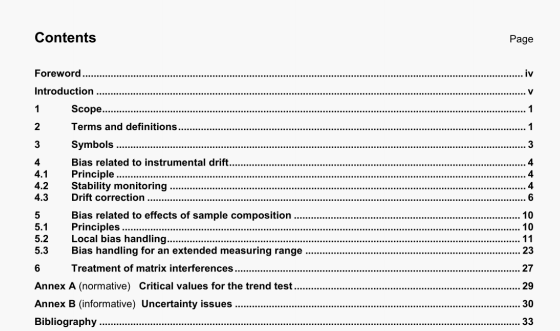ISO 15796 pdf download – ISO 15796 pdf Gas analysis – Investigation and treatment of analytical bias.
For a significance test, the test statistic J2h2 is compared with the critical value for the specified length N of the series under investigation and the specified significance level Values of the test statistic below the critical value indicate a significant trend In this International Standard a significance level of 95 % or 99% is recommended. Critical values for these significance levels ate given In Table A.1, Annex A.
EXAMPLE Consider a genes of dnft-control data (carbon monoade in nitrogen, expressed in moldmd): 1.28. 1.30:
1.30; 1,28: 1,26: 124:127: 127: 1.24; 1.26. For these data the mean-square successwe difference J2 is 38 iOi9, while the variance s2 is 40 x 10S. Hence the test statistic 121s2 takes a value of 0,95. For N — 10, the critical value is 0.751 8 for a significance level of 99 % and 1,062 3 for a signifIcance level of 95 %. Therefore, under the assumptions of independence and normality, the drift-control data exhibit a significant trend on the 95 % level, while the trend is not significant at the 99% level.
Consider now the moditted data sefles generated by Interchange of the 3rd and 9th datum 1,28: 1.30. 124. 128; 1,26:
1.24; 127: 12?: jjQ; 1.26. For these data, the mean square suixessive difference 2 5 i 98 x I 0/9, while the variance ) st is 40- 10 %. Hence the test statistic i2h2 takes a value of 2,45 which means that the modified data series does not exhibit any indication of drift, under the above assianpflons,
For stability monitoring based on regular drift-control measurements, a moving window comprising 10 to 20 data is recommended.
If any of these tests Indicates the presence of variation, then that shall be diagnosed and corrected. If this investigation indicates that there is no fault with the rneasunng procedure, then re-calibration of the instrument is required.
4.3 DrIft correction
4.3.1 General considerations
This clause specifies a general method for post-processing analytical data to correct for instrumental drift. For this purpose an analytical system is treated as a “black box”. Here tne input Is the value of the measurand, i.e. the (true) concentration of the anatyte under consideration in the analysed sample, and the output is the measured value of this analyte concenfrahon
This clause is applicable for absolute methods, i.e. analytical methods where analyte concentration is determined directly, or relative methods where the relationship between measured response and analyte concentration is known It is also applicable for comparison methods, i.e. analytical methods where the relationship between measured response and analyte concentration is deterrn vied empirically by calibration.
Two drift-correction mixtures are required which are typical of the gases for which the analytical procedure is used. Each analyte to be determined by the procedure shall be present r both mixtures, at different levels bracketing an appropnate concentration range. The composition of the mixtures shall be stable, and the concentration of the analytes used for drift investigation shall be known with specified uncertainty.
4.3.2 and 4.3.3 specify two complementary approaches, based on additive and multiplicative drift modelling respectively. Usually only one or neither of these procedures will work, If In a particular case both approaches work, the one with the better performance. I.e. with lower oorrectlon uncertainty, should be used.
NOTE I For en analytical companson method, drift correction is sometimes better performed using measured responses instead of anatyte concentrations.
NOTE 2 Using reference gas mixtures for drift control has the advantage of providing an ‘absolute’ drift correction. 14. retativa to reference values of anatyte concentration. As an alternative, less welt-characterized gas mixtures could be used for drift rection relative 10 analyte concentrations measured at a specified time s. The letter approach would. ii edition. require a proof of stability of the drift-control nsstures. Seconey. the concentrations measured at would have to be investigated for bias in a later stage.
ISO 15796 pdf download – ISO 15796 pdf Gas analysis – Investigation and treatment of analytical bias
